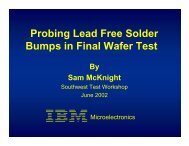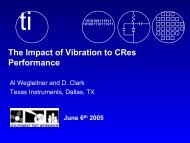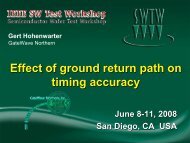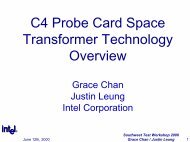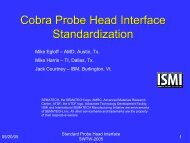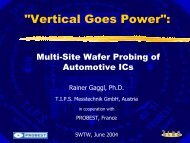Debris and Edge Excursions - Semiconductor Wafer Test Workshop
Debris and Edge Excursions - Semiconductor Wafer Test Workshop
Debris and Edge Excursions - Semiconductor Wafer Test Workshop
You also want an ePaper? Increase the reach of your titles
YUMPU automatically turns print PDFs into web optimized ePapers that Google loves.
Reducing False Defects:<br />
<strong>Debris</strong> <strong>and</strong> <strong>Edge</strong> <strong>Excursions</strong><br />
Rajiv Roy, August Technology<br />
SW <strong>Test</strong> <strong>Workshop</strong><br />
June 8, 2005
Post-probe : Typical Process Defects Detected<br />
Probe mark too big<br />
Probe mark too small<br />
Missing probe mark<br />
Pad discoloration<br />
Probe mark location<br />
Probe mark too close to edge
Probe Mark Inspection<br />
Rectangular bond-pads<br />
Bond pad corrosion<br />
Probe mark area <strong>and</strong> location metrology<br />
Probe mark debris filter – size<br />
Probe mark debris filter – edge debris<br />
Real-time classification of probe mark defects<br />
Non-rectangular bond-pad<br />
Separate image save<br />
Auto-bond pad location
Why Automate Inspection?<br />
System can find defects like these missed by operators:<br />
<strong>Debris</strong> <strong>and</strong> stain<br />
Passivation on pad<br />
Excess metal<br />
flake near pad
The Challenge of Automated Probe Mark Inspection<br />
To make inspection affordable<br />
>15wph or higher throughput needed<br />
Better than 1µm resolution needed for distinguishing<br />
true from false defects
See More at Higher Resolutions<br />
5µm 2µm 1µm<br />
….but takes more inspection time
Throughput vs. Resolution<br />
Seconds to Inspect<br />
Preferred<br />
resolution<br />
2000<br />
1800<br />
1600<br />
1400<br />
1200<br />
1000<br />
800<br />
600<br />
400<br />
200<br />
0<br />
Inspection time increases<br />
approximately by square<br />
of pixel resolution<br />
Preferred<br />
inspection<br />
time<br />
1um 2um 3um 5um<br />
Typical<br />
compromise
The Probe Mark <strong>Debris</strong> Challenge<br />
<strong>Debris</strong> is:<br />
A natural by-product of the probing process<br />
Considered non-critical to device functionality<br />
Automatic probe mark inspection systems have<br />
difficulty differentiating between defects <strong>and</strong> debris.<br />
…… a source of false defects<br />
Aluminum slag/debris –<br />
mistaken for probe mark too big<br />
<strong>Edge</strong> debris – small/faint –<br />
mistaken for edge excursion
The Specific Challenge of <strong>Edge</strong> <strong>Excursions</strong><br />
Distinguishing<br />
between<br />
False edge<br />
defect at 5X<br />
True edge<br />
defect at 5X
Cause of <strong>Edge</strong> Excursion<br />
If probe needles <strong>and</strong> bond pad are not aligned<br />
properly, needles penetrate the edge of the<br />
passivation layers <strong>and</strong> cause a defect<br />
This defect is known as edge excursion or<br />
broken passivation
Rogues Gallery: Images of False vs. True Defects<br />
Real edge excursion – systems can detect<br />
Real edge excursion – systems struggle to detect<br />
<strong>Edge</strong> debris – systems detect but are false defects
The Effect of Simply Detecting “Defects”<br />
(Anomalies)<br />
Inspection Inspection Time: 5 minutes<br />
Results: 5x<br />
Total number of<br />
defects:<br />
Approximate<br />
Review Time:<br />
14400<br />
2 hours 20<br />
minutes<br />
Fast inspection<br />
Unacceptable review time
Detection to Decision for Probe Mark Inspection<br />
Statistical Probe Mark Area Filter<br />
<strong>Debris</strong> Filter for <strong>Edge</strong>
Statistical Probe Mark Area Filter<br />
Assumptions Made:<br />
All bond pads on one die have been subjected<br />
to the same number of touchdowns<br />
Actual probe damage area will not differ in a<br />
statistically significant manner within one die
Probe Mark Area Inspection Without Filter<br />
9.3% 8.9%<br />
16.2% 12.2% 10.5%<br />
9.5%<br />
9.6%<br />
8.3%<br />
30.1%<br />
12%<br />
9.8%<br />
10.3%<br />
13.3%<br />
12.5%<br />
9.5%<br />
13.2%<br />
8.4%<br />
12.8%<br />
9.9%<br />
22.3%<br />
10.1%<br />
9.1%<br />
11.0%<br />
Max. area = 15%<br />
Pad areas greater than max. area fail
Probe Mark Area Inspection With Area Filter<br />
9.3% 8.9% 16.2% 12.2% 10.5%<br />
9.5%<br />
9.6%<br />
8.3%<br />
9.8%<br />
10.3%<br />
9.5%<br />
12%<br />
12%<br />
13.3%<br />
12.5%<br />
13.2%<br />
8.4%<br />
12.8%<br />
9.9%<br />
12%<br />
10.1%<br />
9.1%<br />
11.0%<br />
Max. area = 15%<br />
Pad areas greater than max. area fail
St<strong>and</strong>ard Deviations vs. Performance<br />
Bond Pad No Filter 2σ Filter 3σ Filter 4σ Filter<br />
1 9.60 9.60 9.60 9.60 Average PM Damage % 11.9913<br />
2 9.50 9.50 9.50 9.50 Std Deviation of PM Damage % 4.900919<br />
3 9.30 9.30 9.30 9.30<br />
4 8.90 8.90 8.90 8.90 <strong>Debris</strong> Filter 2 Std Deviations 21.79314<br />
5 13.20 16.20 13.20 16.20 13.20 16.20 13.20 16.20<br />
<strong>Debris</strong> Filter 3 Std Deviations 26.69406<br />
6 12.20 12.20 12.20 12.20 <strong>Debris</strong> Filter 4 Std Deviations 31.59498<br />
7 10.50 10.50 10.50 10.50<br />
8 30.10 11.99 11.99 30.10<br />
9 12.00 12.00 12.00 12.00<br />
10 13.30 13.30 13.30 13.30<br />
11 12.50 12.50 12.50 12.50<br />
12 13.20 13.20 13.20 13.20<br />
13 12.80 12.80 12.80 12.80<br />
14 11.00 11.00 11.00 11.00<br />
15 9.10 9.10 9.10 9.10<br />
16 10.10 10.10 10.10 10.10<br />
17 22.30 11.99 22.30 22.30<br />
18 9.90 9.90 9.90 9.90<br />
19 8.40 8.40 8.40 8.40<br />
20 9.50 9.50 9.50 9.50<br />
21 10.30 10.30 10.30 10.30<br />
22 9.80 9.80 9.80 9.80<br />
Count of number of<br />
pads<br />
8<br />
6<br />
4<br />
2<br />
0<br />
8<br />
Histogram of Probe Mark size<br />
11<br />
14<br />
17<br />
Reduce<br />
overkill<br />
20<br />
23<br />
26<br />
Probe mark area (%)<br />
29<br />
Reduce<br />
escape<br />
32
Parameters for Area Filter <strong>Test</strong><br />
<strong>Wafer</strong> size:<br />
8-inch<br />
Inspected die: 713<br />
Die size: 5897um x 6349um<br />
Pads/die: 38<br />
Max. area: 25%<br />
Std. Devs: 1.1
Defect Map Without Area Filter<br />
False “too big”<br />
defects from debris<br />
Probe “Too Big”<br />
Pass
Defect Map With Area Filter<br />
True “too big”<br />
defect<br />
Probe “Too Big”<br />
Pass
Pad Areas Before & After Filter<br />
Before Filter:<br />
Pad #8 Fails<br />
Pad #9 Fails<br />
#8 #9<br />
After Filter:<br />
Pad #8 Passes<br />
Pad #9 Fails
Statistical Probe Mark Area Filter<br />
Advantages<br />
Easy to use – user only specifies filter threshold level<br />
Fast – filter does not reduce machine throughput<br />
Effective – debris which significantly increases the perceived<br />
probe damage area is automatically cleared<br />
Automatically adjusts to variability of probing process. A well<br />
controlled process will have a lower st<strong>and</strong>ard deviation,<br />
resulting in a tighter debris filter threshold<br />
Disadvantages<br />
Not effective for small debris which does not significantly<br />
increase the probe damage area but does occlude the bond<br />
pad edge is not cleared <strong>and</strong> may cause false rejects<br />
May cause escapes if one probe needle creates a significantly<br />
larger damage area than other probe needles
Probe Mark <strong>Debris</strong> Filter – <strong>Edge</strong> <strong>Debris</strong><br />
Sample defect<br />
images<br />
All three defects caught as probe position<br />
Sample defect<br />
images cleared with<br />
edge debris<br />
filter algorithm<br />
All three defects caught as probe position initially<br />
Gradient analysis<br />
around the edge of<br />
the bond pad
Method 1 – No <strong>Debris</strong> Filters<br />
Inspection<br />
Results:<br />
10x<br />
Inspection<br />
Time:<br />
Total number<br />
of defects:<br />
10 minutes<br />
30 seconds<br />
7100<br />
Approximate<br />
Review Time:<br />
1 hours 10<br />
minutes
Method 2 – With <strong>Edge</strong> <strong>Debris</strong> Filter<br />
Inspection<br />
Results: 5x<br />
Inspection Time:<br />
4<br />
minutes<br />
30 secs<br />
Total number of<br />
defects:<br />
Approximate<br />
Review Time:<br />
Number of defects caught<br />
as probe position<br />
Number of defects caught<br />
as edge defects<br />
680<br />
7<br />
minutes<br />
279<br />
401
Manual Review of Defects<br />
Inspection<br />
Results:<br />
Total number<br />
of defects left:<br />
300
<strong>Edge</strong> <strong>Debris</strong> Filter<br />
Advantages<br />
Fast – filter does not reduce system throughput<br />
Effective for small debris – debris which does not<br />
significantly increase the probe damage area, but does<br />
occlude the bond pad edge, is automatically cleared based<br />
on position variation<br />
Easy to setup – specify the width of edge analysis<br />
Disadvantages<br />
Have not eliminated review – while the amount of review<br />
has been significantly reduced, a fair amount of review is<br />
still required
Summary of <strong>Debris</strong> Filter Usage<br />
Type of <strong>Debris</strong> Filter<br />
Size<br />
Cantiliver<br />
Probing<br />
Applicable<br />
Vertical Probing/<br />
Microspring<br />
Not an issue<br />
<strong>Edge</strong> <strong>Debris</strong><br />
Applicable<br />
Not an issue
Acknowledgements<br />
This data was generated by the following<br />
August Technology personnel:<br />
Woo Young Han<br />
Max Guest<br />
Steve Frankeberger
4900 West 78 th Street<br />
Bloomington, Minnesota 55435<br />
Tel: (952) 820-0080<br />
Rajiv.Roy@augusttech.com<br />
www.augusttech.com<br />
Thank You


